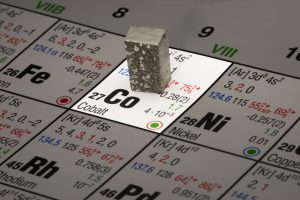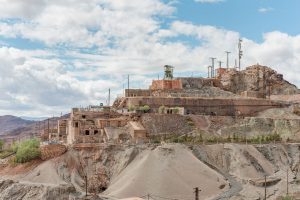Cobalt is used in most modern batteries such as the lithium-ion battery or the nickel-metal hydride batteries that have been known for years. Cobalt is important for the human organism because vitamin B12 contains cobalt. Like many other metals, cobalt has a shiny grey metallic appearance. It is a heavy metal due to its high density.
How could I come in contact with it?
 As cobalt is used in some everyday applications, you may also come into frequent contact with it. Guitar strings and permanent magnets can contain cobalt. Tools that have to withstand particularly high loads also often contain cobalt (as tungsten carbide-cobalt). Cobalt improves the mechanical properties of prostheses, so you can have cobalt in your own body. Deep blue glass objects often contain cobalt as a colour pigment.
As cobalt is used in some everyday applications, you may also come into frequent contact with it. Guitar strings and permanent magnets can contain cobalt. Tools that have to withstand particularly high loads also often contain cobalt (as tungsten carbide-cobalt). Cobalt improves the mechanical properties of prostheses, so you can have cobalt in your own body. Deep blue glass objects often contain cobalt as a colour pigment.
How dangerous is the material for humans and the environment?
Cobalt is not dangerous to humans or animals in low doses. As it is used in steel, glass or comparable solid materials, it normally remains firmly bound and no large quantities of cobalt or its compounds are released. If larger quantities of cobalt are ingested, this can lead to poisoning. As with nickel, cobalt can also trigger a contact allergy.
In small quantities, cobalt is vital for most living organisms, including humans. It is contained in the vitamin B12 group. A deficiency of this vitamin can lead to changes in the blood count, damage to the central nervous system and other diseases.
Conclusion
Cobalt is a good example of Paracelsus‘ still valid saying “The dose makes the poison”: small amounts are vital, larger amounts can be harmful to health. Under normal living conditions, a high uptake of cobalt is unlikely.
By th way…
Vegans should have the vitamin B12 level in their blood checked occasionally, as there is no vitamin B12 in a purely plant-based diet. However, it can be supplemented vegan via freely available preparations.
Properties and Applications
Cobalt is a shiny, silvery metal that is used in many metal alloys and other compounds such as ceramics (see also our article on tungsten carbide cobalt, a hard metal compound that is particularly hard in keeping with its name). Cobalt can be used to improve the temperature properties and corrosion resistance of steel, making it suitable for use in aircraft or gas turbines. In addition, cobalt itself is ferromagnetic and can be used as a component of permanent magnets (samarium-cobalt magnet). Guitar strings can also be made of cobalt alloys.
Cobalt-alloyed steel is used in apparatus in the chemical industry. There are also a number of cobalt catalysts that can be used to control chemical processes such as desulphurisation and the production of synthetic fuels. Cobalt compounds also play a role as colourants in ceramics and glass (cobalt blue).
 With more than 45% and thus the largest part of the cobalt production (as of 2017, and rising), cobalt now plays a decisive role as a component of the electrode material in nickel-metal hydride, nickel-cadmium and lithium-ion batteries. While the first lithium-ion batteries consisted of lithium-cobalt dioxide (LiCoO2), today so-called NMC (nickel-manganese-cobalt) lithium composite oxides are used. Efforts are increasingly being made to move away from cobalt, as it is sometimes mined under very questionable working conditions (child labour, slave labour). Nickel-cadmium and nickel-metal hydride batteries, which also contain cobalt, are on the market since a long time.
With more than 45% and thus the largest part of the cobalt production (as of 2017, and rising), cobalt now plays a decisive role as a component of the electrode material in nickel-metal hydride, nickel-cadmium and lithium-ion batteries. While the first lithium-ion batteries consisted of lithium-cobalt dioxide (LiCoO2), today so-called NMC (nickel-manganese-cobalt) lithium composite oxides are used. Efforts are increasingly being made to move away from cobalt, as it is sometimes mined under very questionable working conditions (child labour, slave labour). Nickel-cadmium and nickel-metal hydride batteries, which also contain cobalt, are on the market since a long time.
For humans and animals, cobalt is a key component of vitamin B12 (more precisely, cobalamins). Vitamin B12 is important for the nervous system, cell reproduction and haematopoiesis. The body needs small amounts of cobalt, which is therefore an essential element. The human body cannot produce vitamin B12 for itself; it must be obtained from food. A number of other enzymes also contain cobalt.
Cobalt is often used in orthopaedic implants because it is inherently stable as an element in alloys under physiological conditions. Gamma radiation from the radioactive 60Co nuclide is used in the treatment of cancer as well as for the disinfection of medical devices and for the preservation of food. Due to the wide range of applications of this radionuclide, it is one of the most important of all.
Natural occurence
Cobalt occurs naturally as an ore and must be mined and processed until it is available as a metal. Cobalt-containing ores often also contain other metals such as copper, nickel and chromium, meaning that the ores are mined for all of these metals. Cobalt has not yet been mined from the manganese nodules found on the seabed, which contain cobalt and other valuable metals in addition to the name-giving metal. If such mining were to begin, unexplored ecosystems could be severely damaged.
The world's largest producer of cobalt is the state of Congo. The mining of cobalt ore is viewed particularly critically in this country because numerous uncontrolled mines lead to frequent deaths, including those of children working there illegally. Other, far less important mining areas are located in Russia, Australia and Cuba.
Production
The extraction of cobalt depends heavily on the type of ore available. Many different industrial processes are used, which always involve considerable energy input, as cobalt is often present as cobalt oxide, sulphide or arsenide in mixtures with other metal oxides or salts. Cobalt can only be separated from other substances from this mixture by using auxiliary agents such as coal, silicates or electric current. It is then obtained as metallic cobalt or pure cobalt oxide. The metals with which cobalt is mixed are often also valuable, so that several other valuable materials, e.g. copper or nickel, can be recovered at the same time during the processing procedures.
Production
Cobalt and its compounds are largely mined as a by-product in nickel and copper deposits. Therefore, many sustainability indicators for metallic cobalt and cobalt compounds are difficult or impossible to determine. Pure cobalt mining sites account for only a small percentage, e.g. in the Democratic Republic of Congo. After the Congo, most cobalt is mined in Australia and Cuba. Most of the mining is done by open pit mining, but some cobalt is also mined underground. In addition, cobalt is extracted from overburden that was not used for cobalt extraction at the time of mining, but only for nickel or copper extraction. In general, an increasing demand for cobalt, especially for batteries, is forecasted. Approximately 40% of the cobalt produced worldwide is used outside the battery sector.

Cobalt mine in Bou-Azzer @ cornfield -stock.adobe.com
Resource consumption during processing
For the extraction of cobalt, rainforest is cleared in some countries, on the one hand to make mining areas accessible, on the other hand to secure shafts with the wood. During mining, there is a high consumption of water per ton of ore extracted. Energy consumption for processing the ore is high. The spoil heaps also cause high land consumption.
No renaturation or recultivation has taken place on many former mining areas (e.g. silted-up rivers). This is also due to the large number of smaller mining sites with different operators, with unclear responsibilities for recultivation.
Safety
There are reports of health hazards from dust generated during extraction in opencast mines. Inhalation causes lung irritation. As for other materials, the smaller the particles, the stronger the effect of the dust. Similarly, a skin sensitizing effect of cobalt and its compounds has been described. Cobalt is toxic to aquatic organisms in both the short and long term.
Other safety concerns with cobalt mining include transportation safety of degradation products (e.g., uranium and associated radioactivity) and process chemicals (e.g., acids). Pipeline leaks or accidents occasionally occur and can pose health hazards to the public. By-products of cobalt mining can include arsenic and radioactive uranium.
Emissions
CO2 emissions per ton of ore mined and processed amount to 20 - 620 kg CO2, depending on the deposit. Around 80% of the cobalt mined worldwide is processed in China, resulting in further emissions from transport. The vehicles and machines used for mining cause about 50% of the CO2 emissions during extraction.
In addition to the high dust formation during ore mining, sulfur dioxide emissions ("acid rain") also occur during smelting, which are not removed by filter systems at all extraction sites. Acid mine drainage is produced during underground mining. As a result of past mining activities, many waters in the vicinity of extraction sites are contaminated with metals (e.g. arsenic). The overburden has led to the silting up of many rivers, which take decades to regenerate.
In some extraction sites, the overburden shows radioactivity due to a high uranium content.
Social Aspects
Particularly in informal small-scale mining, there are isolated reports of child labor, which is associated with a loss of health and educational opportunities for the children concerned. Similarly, accidents occur in inadequately secured tunnels, especially in small-scale mining. Corruption also occurs, and small-scale miners have few rights vis-à-vis middlemen (e.g., in price negotiations).
The entrepreneurial concentration of mining cobalt is considered high. This means that only a few benefit from the profits of cobalt mining. It is difficult to track the value added in the mining countries, but since China dominates further processing (refining), it can be assumed that most mining countries only earn from the material value.
The weighted country risk for the countries of origin of cobalt, based on the indicators of the World Bank (Worldwide Governance Indicators) shows a high risk. This means that there is a great need for improvement in, among others, political stability, voice, security and anti-corruption in many producing countries.
For responsible metal production, due diligence in supply chains is becoming increasingly important in the EU (Act on Corporate Due Diligence Obligations in Supply Chains). The law requires the documentation or certification of social standards and occupational health and safety, but initially only for companies with more than 3,000 employees.
Waste and recycling
Cobalt is currently still available in many deposits. Material recycling has so far only taken place to a small extent; in 2019, the rate was around 10%. However, this rate is expected to increase, also due to the legal requirements for recycling rates for batteries. The European Battery Regulation sets a recycling rate of 90% for cobalt in 2027. The recovery of cobalt from batteries allows direct reuse as cathode material (no downcycling). However, no complete recovery takes place.
How can the material be made more sustainable?
There is a trend towards partial or complete substitution of cobalt in cathodes, for example by the rare earth element neodymium. In general, the longer use of batteries in many electronic devices (e.g. smartphones) is a contribution to sustainability, as is the return of devices with batteries for recycling.
CO2 emissions from vehicles and machinery during the extraction process should be reduced by electrifying fleets.
The social aspects of sustainability in particular can be achieved by improving transparency in supply chains. Various international organizations are working on proofs of origin for cobalt (certifications), some of which are already being applied. These ensure that certain social and safety standards are met in the mining operations.
 >
>